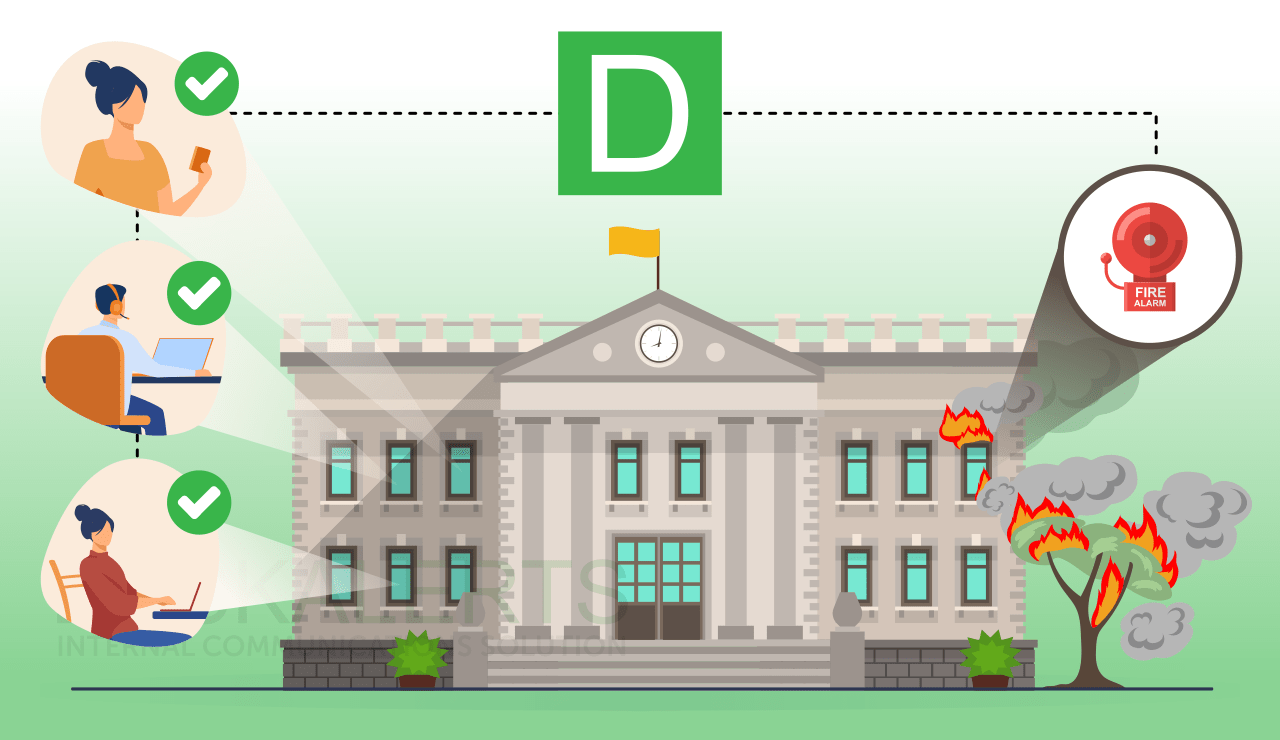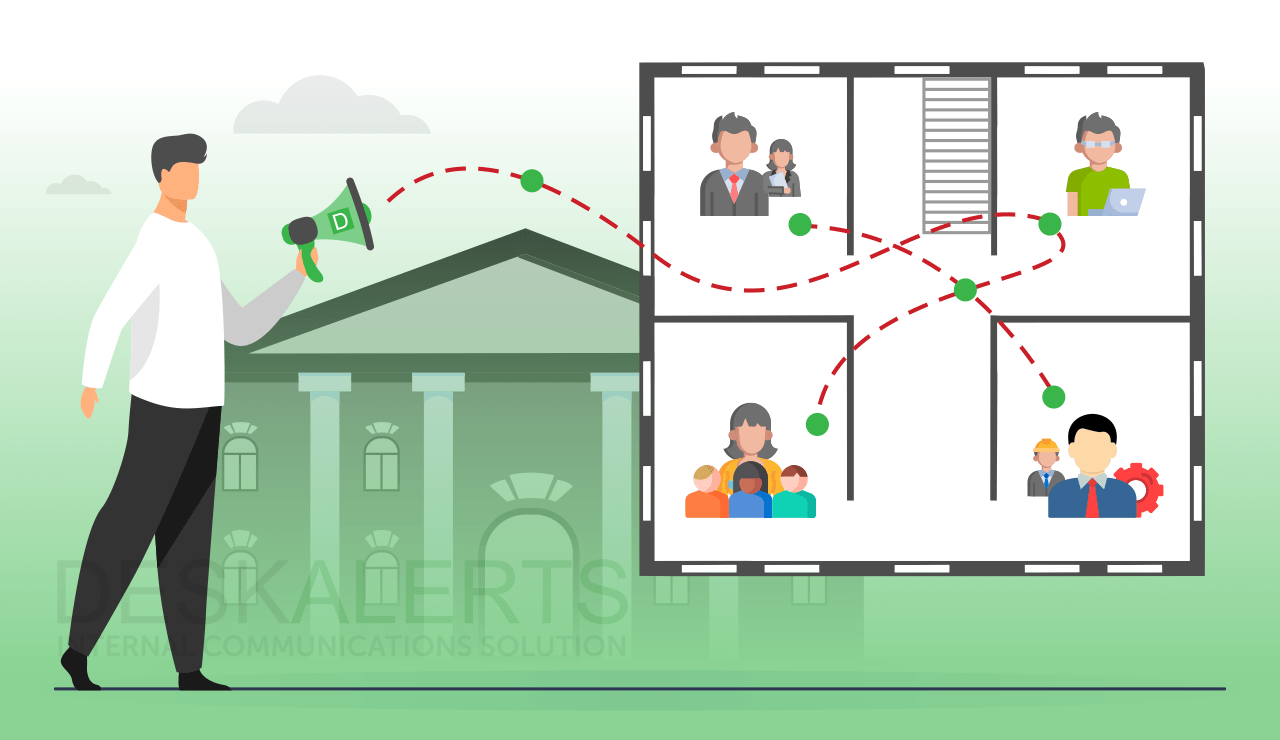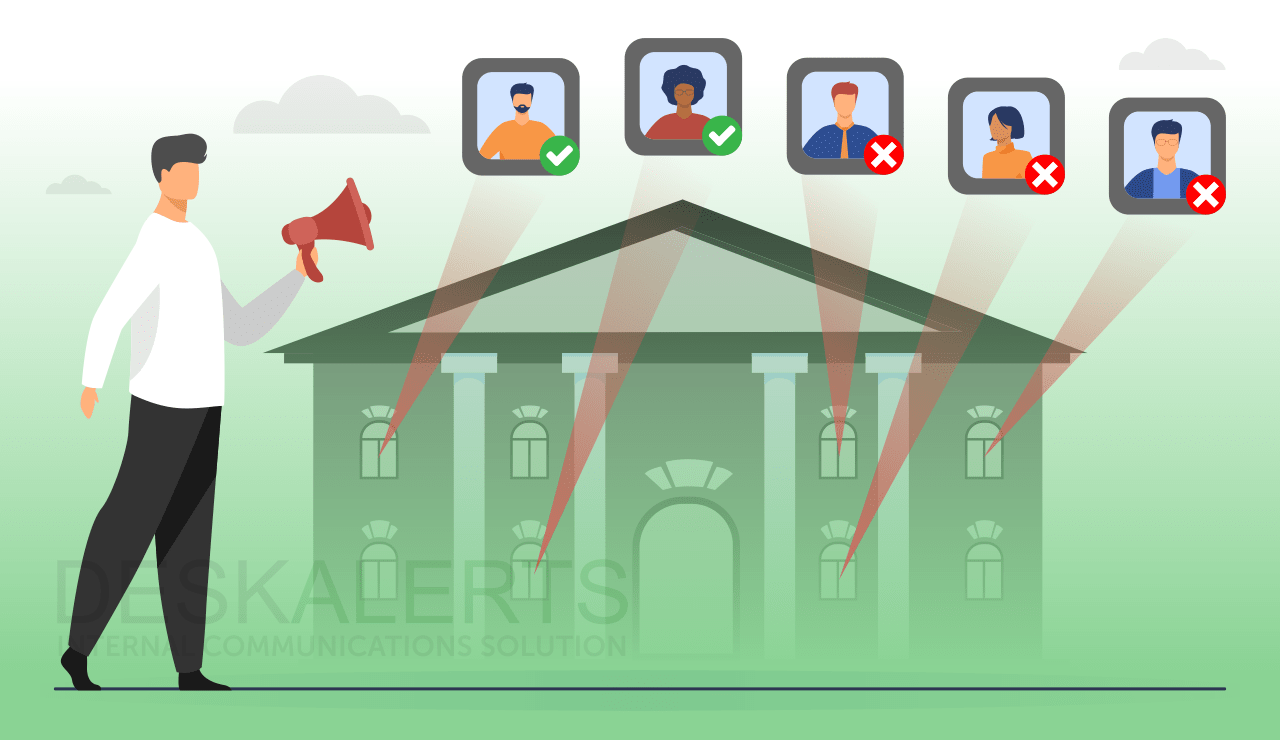
Around 18 % of the world’s workforce are employed in the public sector, according to data from the Organisation for Economic Co-Operation and Development.
These workers perform in a diverse range of roles within often large and complex organizations, which can make communicating with them adequately especially challenging. However, in order to achieve effective and efficient delivery of government services to stakeholders, employees working in this sector must be well informed.
That’s where good government communications and public sector employee engagement strategies are needed.
Table of contents
The importance of public sector internal communication and engagement
Government internal communications challenges
How to improve employee engagement and motivation in the public sector
The importance of internal communications during a crisis
How to improve internal communication and public sector employee engagement with DeskAlerts
The importance of public sector internal communication and engagement
Having an internal communication strategy is important in every organization. It helps to ensure that your employees have the information they need to do their jobs well. This means that in turn they will deliver services to your stakeholders well.
The benefits of good government internal communications practices include:
- Ensuring employees understand key priorities.
- Ensuring work is carried out efficiently, effectively and correctly.
- Minimizing exposure to risk.
- Sharing information between teams.
- Fostering a collaborative and innovative culture.
- Boosting government employee engagement.
Employee engagement is closely linked to internal communication: it is one of the key factors influencing how engaged employees feel within their organization.
When employees are engaged, they are more motivated, productive, efficient, and have higher job satisfaction levels. When employees aren’t engaged, it can mean that work isn’t being done, people are stressed and unhappy, can make mistakes, and are likely to experience a higher level of staff turnover. As a result, employees with longer tenure and lots of corporate knowledge might leave.
To be successful at both internal communications and engagement, you need to understand your organization and its culture. This means looking at who the different internal audiences are, what they need to know and the best way to reach them. When you understand this, you’ll be in a good place to develop key messages and deliver engagement activities to them that are tailored to their needs and interests.
What is government communications and public engagement
Internal communications shouldn’t be confused with external communications activities with the general public.
Government communications and public engagement focus on disseminating information, gathering feedback, and fostering transparency with the general public. This involves utilizing various channels such as social media, public meetings, and outreach programs.
In contrast, internal communications within the public sector concentrate on ensuring effective information flow among employees, departments, and agencies to facilitate coordination, collaboration, and organizational alignment towards common goals.
Government internal communications challenges
Public sector organizations aren’t alone when it comes to having difficulties with internal communication. But this sector certainly has its own unique issues.
1. Public sector organizations are complicated
The public sector is a very different beast from the private sector. Quite often, they are hierarchical and bureaucratic. This means that information doesn’t always filter through to employees on the ground very well. It will depend on factors such as how good the managers up the line are at communicating, approvals processes (these can be at glacial pace in the public sector) and how well the communications are written (public sector communications are notorious for being filled with jargon).
Larger organizations may have lots of different departments carrying out different work in the community. They may be based in multiple locations across a large geographic area and time zones. All of these things make government communications challenging.
Solution: You need an overarching internal communication plan that sets out a clear goal for communicating within your public sector organization. These government communication strategies should include establishing protocols about how to communicate, who will communicate, streamlining the approvals process, the channels you will use to communicate and a commitment to writing in clear, concise and plain language.
2. Too much focus on external communications
In many public sector institutions, there is a lack of resourcing to put effort into internal communication, focusing instead on using these resources to provide external communication: telling the public about projects, services, and initiatives offered by the organization. Unfortunately, this is very short-sighted. If your own people inside the organization don’t know about or understand the work that it does, they will never be able to communicate with stakeholders effectively!
Solution: Internal communication should form a component of every significant project that your organization carries out. You can provide an internal communications calendar template to project teams to fill out and guide them to create key messages and when and what channels they will use to communicate.
3. Constant change can be confusing
Public sector organizations are tasked with implementing policies and projects on behalf of governments, be they national, state, or regional. The thing about governments is that they change quite regularly, so too can the organization’s priorities.
When the work of one team in the organization changes drastically, team members in other parts of the organization may not be aware of it as information silos tend to develop – which often hampers government communications. There are many consequences of this: it can lead to mistakes being made, incorrect advice being given and even depletion of employee morale as people feel like they don’t understand what is happening in their organization and aren’t truly a part of it.
Solution: Develop appropriate change management communication strategy. This should explain what is happening, why it’s happening, how it will happen when it will happen and who it will affect. Internal communications campaigns that use a range of channels to deliver content – including visual content – should be deployed to ensure that people understand the change and get on board with it.
One way to make your government change communications stand out is to give them a brand identity of their own that is a sub-brand of your overall corporate branding so that employees will know to look out for them as updates.
4. Shrinking budgets
Public sector organizations have long grappled with tight budgets and the constraints that come with them, meaning that there often isn’t enough funding with projects to cover off internal communications as a component. Austerity measures being introduced by governments worldwide in response to financial pressures caused by COVID-19 are only amplifying this headache and stymying effective government communications.
Solution: Look for ways to maximize your internal communications reach for a little initial outlay. For example, purchasing an internal communications software tool that doesn’t need to be tied to specific project funding can be used for your internal communications needs.
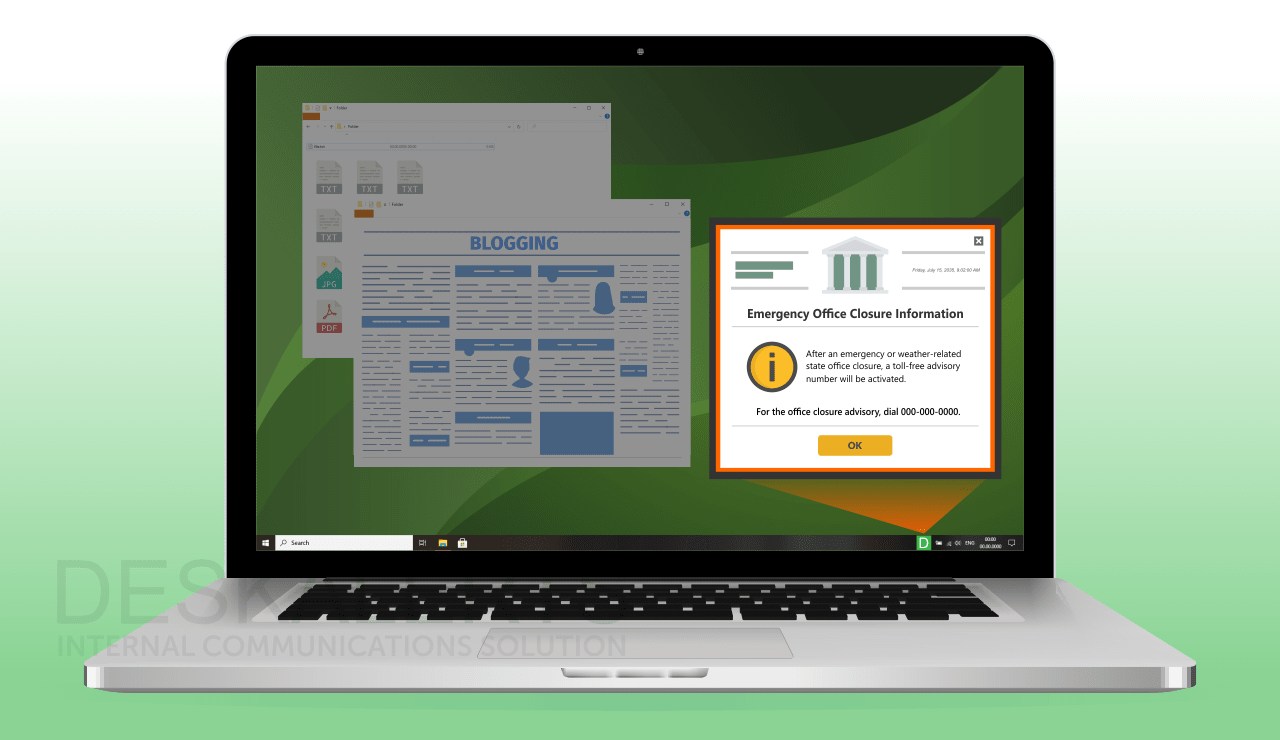
5. Battling information overload
Like workers in other sectors, public sector employees are increasingly plugged into a digital world where they receive communications 24/7 across a range of channels. In the workplace alone this might include emails, phone calls, text messages, video calls, group chats, instant messenger messages and more. The balance between home life and work life is blurring too – and since COVID-19 has meant many employees are working from home, the lines get even more blurry. This means people are getting work notifications after hours: on weekends and in the evenings.
While people have never had access to so much information ever before, it also has a downside: people have so much information that it can be overwhelming, and they can miss important information in the deluge of incoming material.
Solution: Dedicated communication channels, such as pop-up alerts, that cut through all the digital noise and get immediate attention should be included in government communication strategies, ensuring that important information is seen.
6. The intranet isn’t very useful
All too often, public sector agencies think that putting information on the corporate intranet will solve all of their internal communication needs. This thinking is flawed for several reasons:
- Intranets have become a “dumping ground” for all sorts of information, documents and policies. Once they’re put on there they aren’t reviewed regularly and outdate information can still circulate.
- Intranets are often complex and difficult to navigate, making it difficult for people to quickly find the information they need.
- Many public sector organizations haven’t had the budget to update their corporate intranet and are using sites designed more than 10 years ago that aren’t user-friendly at all.
- There is an assumption people will actually check the intranet to find out new information. However, research shows this isn’t the case.
A study by Prescient Digital Media found that 31% of people never look at their corporate intranet, while just 13% of employees say that they look at the intranet on a daily basis.
- Even if you make the intranet everyone’s default home page, you can’t be guaranteed that they will read it and pay attention to it.
- If people don’t know something exists in the first place, they aren’t going to go searching for it on the intranet!
Solution: Streamline your intranet and regularly review and delete outdated content: if you still have policy documents from 1999 there’s a good chance you need to do this! Find other ways to update your employees about new information and point them to where it lives on the intranet site, for example, by using a scrolling desktop ticker.
How to improve employee engagement and motivation in the public sector
A 2017 poll by the Association for Talent Development found that public sector employee engagement in the USA is lower than employee engagement in the private sector. It also found that local government people are more engaged than those who work for federal or state governments.
There’s no one-size-fits-all approach to improving government employee engagement, but in general, improving internal communication will assist in general.
Other factors to consider when engaging government employees include:
- Paying attention to the working environment (conditions, benefits, etc).
- Having leadership model good behaviors.
- Building a positive work culture that encourages respect and embraces diversity.
- Providing training and development opportunities.
- Rewarding and recognizing employee contributions.
- Providing meaningful work.
- Celebrating success.
To understand the level of engagement in your organization, you can distribute benchmarking surveys that you can compare at different time intervals to compare whether things are improving or deteriorating, then devise appropriate government communication strategies that will help with engaging your government employees.
The importance of internal communications during a crisis
A crisis can happen at any time and often when you are least expecting it. In the public sector this can include being caught up in natural or man-made disasters, terrorism and other violence. It can also involve issues such as cyber-attacks, mass systems outages that affect stakeholders, political scandals and policy failures.
When one of these issues befalls a public sector institution, there’s often an immediate focus on communicating with external audiences, and internal communications can be overlooked. This is problematic because when you don’t communicate effectively with your own people in a crisis, you can inadvertently make the crisis much, much worse.
When a crisis happens, you need to:
- Get ready to implement your pre-prepared government communication strategy.
- Communicate with employees BEFORE you communicate with the outside world.
- Communicate clearly and concisely and provide all the relevant information and outline any steps that employees need to take, if relevant.
- Be open and transparent – don’t lie, you’ll be caught out and things will be worse!
- Provide regular updates throughout the crisis.
- Ensure that message delivery is coordinated.
- Remind employees about any relevant policies – for example, not speaking to the media. Or where they can get any assistance.
But before a crisis ever happens, it’s important you have a crisis communication plan in place. You should also plan for various scenarios that your organization might find itself caught up in and develop responses and templates to reflect this.
Some crises come with a little bit of warning, so in these circumstances, you have a bit of a head start to work on your messaging and plan to let employees know.
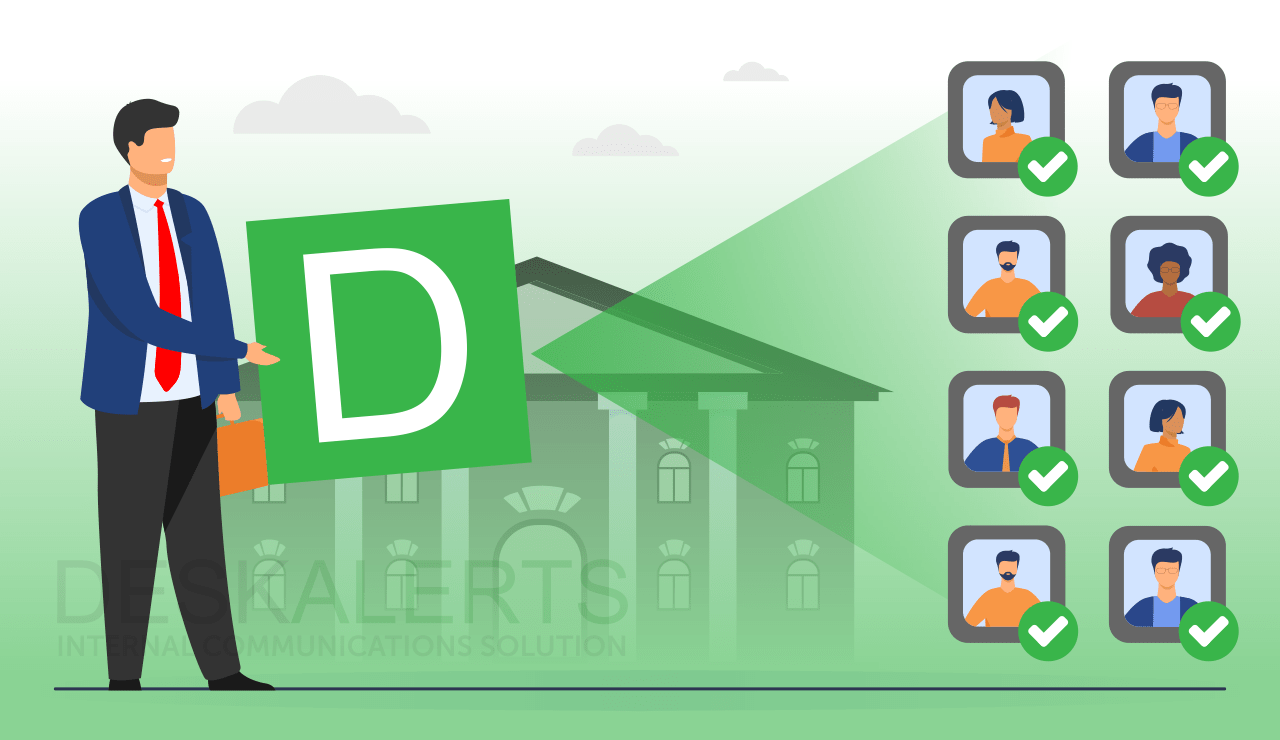
How to improve internal communication and public sector employee engagement with DeskAlerts
DeskAlerts is a cost-effective internal communications software system that is easy to set up in your organization to begin seeing immediate improvements in the effectiveness of your government communications.
You can install it on any Windows or macOS computer or on any Apple or Android smartphone or tablet to ensure that you can reach your employees with important information, no matter where they are located. This is particularly important during times of uncertainty in the COVID-19 pandemic, where snap lockdowns and other measures mean that employees may have to work remotely with little or no warning.
The system is designed to be disruptive and to defeat information overload by bypassing overused channels like email, to deliver information in a highly visible way. Our government communication solutions includes sending pop-up alerts, push notifications, desktop tickers, screensavers, corporate wallpapers, digital signage and more. It can also help you to deliver any initiatives you have designed to help with engaging government employees.
You can use DeskAlerts to overcome these common government communications challenges:
1. Better delivery of IT communications
When systems go down unexpectedly, or if there is planned maintenance or software updates, your employees need to get the right information about it quickly and on time so that they can act accordingly. Public sector employees are often time-poor, spending too much time in meetings or wading through emails. Using pop-up alerts and scrolling tickers, you can make sure that employees get the appropriate outage information they’ll pay attention to.
2. Enhance your emergency communications
During an emergency, it’s important to use all the communication channels you have at your disposal. DeskAlerts will let you deliver urgent notifications directly to desktops and mobile phones with the click of a button. You can choose different color schemes for your emergency messages, allowing employees to easily determine the threat level.
3. Achieve better compliance results
Compliance communication is important for the public sector. There are lots of rules, regulations, laws, policies, procedures and codes of conduct that need to be adhered to. DeskAlerts can be used to run compliance campaigns promoting these requirements. You can also ensure that employees accept and acknowledge that they understand any new requirements they must adhere to by sending a pop-up notification that requires their acknowledgment.
4. Dealing with change and crisis communications
When there’s a major change, or your organization is embroiled in a crisis, consistently and regularly updating your employees will help you to navigate through the situation. DeskAlerts can be used to send different types of government communication messages across the various channels, including video messages from managers. If you’re moving buildings, you can keep employees in the loop by sending notifications to their phones.
5. Improve internal processes
Because DeskAlerts channels are highly visible, they are perfect for delivering important work-related information. For example, law enforcement agencies can distribute photos of missing people, information about suspects, reports, crime activity maps and more. Local governments can use local government communications software to remind employees about dates of important reports, inclement weather that might influence their service delivery and communications with residents – and even send parking notices.
6. Government employee engagement and appreciation
When it comes to engaging government employees, don’t be afraid to get creative and use DeskAlerts to show appreciation – for example personalized messages to employees who have done an excellent job, screensavers celebrating team success or digital signage reminding people about upcoming events. The RSVP function can also be used to invite people to events in the first instance, which is also a driver of government employee engagement.
7. Informing about employee benefits, workplace health and wellness
When your organization invests in these programs for employees, it’s important that you remind people about them regularly so that they can make the most of them. Screensavers or corporate wallpapers promoting these initiatives can help to keep them front of mind.
8. Education and learning
When you need to test your employees’ knowledge on certain subjects, for example, cybersecurity, you can do so in an entertaining way by using the surveys, polls and quizzes module in DeskAlerts – and you’ll get the results in real time!
***
It’s a challenging time to be an internal communication professional in the public sector. But having the right strategies, tools and resources at your disposal can help streamline and improve your internal government communications and public sector employee engagement.
Get in touch with our team of experts today for a free demo to find out how DeskAlerts could work in your organization.
FAQs:
What is the importance of communication in government?
Internal communication within government organizations is vital for ensuring smooth operations, transparency and effective decision-making. It ensures the dissemination of policies, directives, and updates so that all employees are informed and aligned with organizational goals.
Clear communication ensures greater collaboration among departments, enhances efficiency and improves productivity. It enables the timely exchange of information, critical for responding to emergencies or implementing new initiatives promptly.
How does the government communicate with the public?
The government communicates with the public through various channels, including official websites, social media platforms, press releases, public announcements and press conferences. Additionally, government agencies often engage in public outreach programs, town hall meetings and other types of public consultations to gather feedback and address concerns. Public officials also communicate through televised addresses, speeches,and interviews to share information, explain policies and attempt to build trust with the citizens they serve.
How to effectively communicate with government?
To effectively communicate with government agencies as an individual or on behalf of an organization, there are several approaches to take. This can include using official channels such as government websites, contact forms, and designated hotlines. Engaging with elected representatives, attending public meetings, and participating in public consultations are also effective methods. Additionally, leveraging social media platforms and submitting formal written correspondence can help convey messages and concerns to relevant government officials and departments.
What is an example of public service communication?
Public service communication can include campaigns promoting health awareness, disaster preparedness, and civic engagement. For instance, a campaign educating citizens about vaccination benefits, safety measures during natural disasters, or encouraging voter registration are government communication examples. These initiatives typically involve the use of various media channels such as television, radio, social media, and community events to reach the target audience effectively.
 Caroline Duncan
Caroline Duncan







